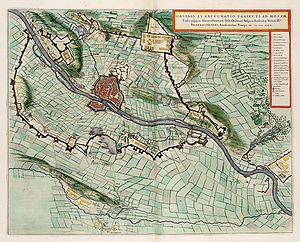Capture of Maastricht
| Siege of Maastricht | |||||||
|---|---|---|---|---|---|---|---|
| Part of the Eighty Years' War | |||||||
 A map of the siege of Maastricht 1632. |
|||||||
|
|||||||
| Belligerents | |||||||
|
|
|
||||||
| Commanders and leaders | |||||||
|
besieged relief forces |
besiegers |
||||||
| Strength | |||||||
|
besieged 2,000 infantry 3,000 armed citizens relief forces 18,000 infantry 6,000 cavalry |
besiegers 17,000 infantry 4,000 cavalry |
||||||
The siege of Maastricht was fought between June 9, 1632 to August 22, 1632 where the Dutch commander Frederick Henry, Prince of Orange eventually captured the city from Habsburg forces.
Following upon his success of 1629, the capture of 's-Hertogenbosch, the Dutch commander Frederick Henry, Prince of Orange marched up the river Maas (Meuse) in 1632. The aim of the campaign was an ambitious one - the capture of the strong fortress of Maastricht, which was deep in Spanish-held territory. As Prince Henry marched south, the fortified places of Venlo and Roermond capitulated with very little resistance thanks to the efforts of the Stadtholder of Upper Gelderland, Van der Bergh, who was sympathetic to the Dutch cause.
In 1632 Maastricht was ringed by tall medieval walls with a large number of towers. A few earthen bastions and demi-lunes had been constructed to strengthen the defences against artillery. A flooded ditch fed by water from the river protected the low-lying parts of the defences.
The town lies on both sides of the river Maas, which is particularly wide at Maastricht, so any attacker would have his forces split into two by the river. The garrison, commanded by Guillaume de Bette, baron of Lede, was strong, loyal to Spain and determined to resist the Dutch army. In addition to all this, there was a strong chance of a relief army being sent to Maastricht to raise the siege.
Frederick Henry arrived before Maastricht on June 10 with 17,000 infantry and 4,000 cavalry. This included some veteran English and French troops, who were to play a significant role in the siege. He at once began to dig lines of circumvallation and contravallation. These were earthwork fortifications that ran all the way round the town and were built to protect the besiegers' camps against sorties made by the garrison or attacks from a force outside the town. There were various forts and redoubts along these lines protecting the high ground or vulnerable sections. Where the lines met the river above and below the town pontoon bridges were constructed, allowing the besiegers to transfer troops and material from one side of the river to the other. The strength of these lines was to prove critical to the outcome of the siege.
...
Wikipedia
